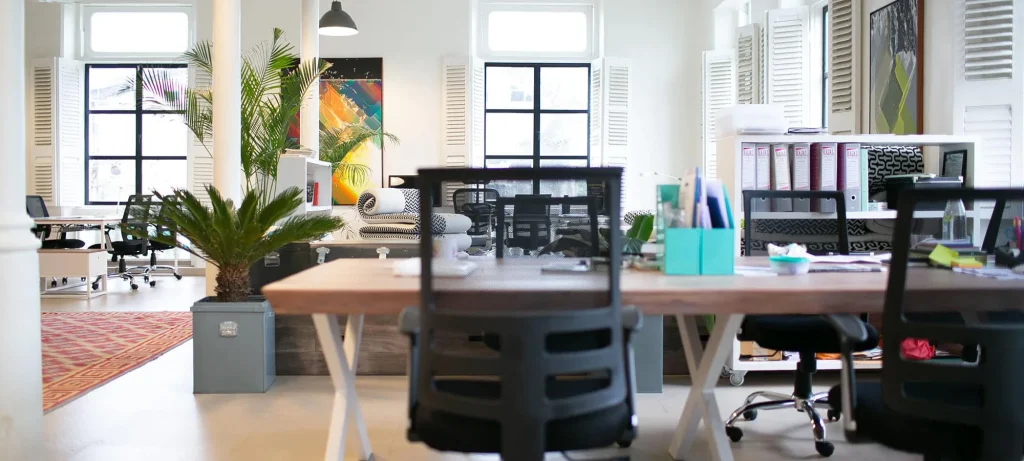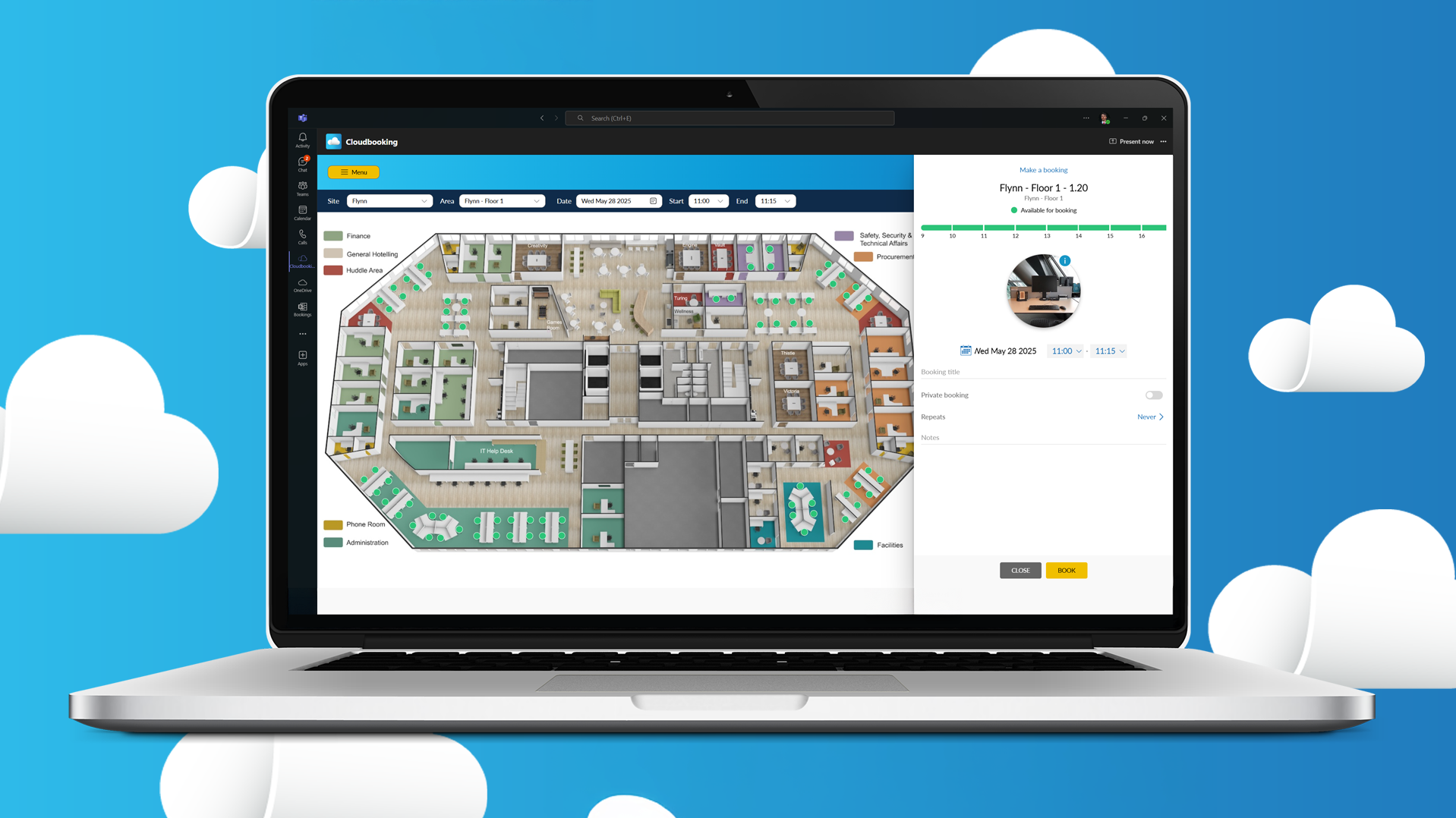
The global pandemic has sped up the pace of workplace change like never before. While the cogs were already in motion for some of today’s trends, we now see them be adopted at an accelerated speed. Meanwhile, technologies are rapidly being developed to accommodate and facilitate the changing workplace. In this post, we take a look at the top workplace trends of 2021.
Get a free demo
Enquire about a no-obligation demo today and get an exclusive hybrid working research paper — for free. Created in partnership with YouGov, this invaluable guide provides essential insights into developing your own effective hybrid strategy. Click below.
1. Agile Working Becomes the Norm
The global pandemic, and subsequent lockdowns in many countries, required people across many industries to switch to home working rapidly. While flexible working was a trend that was already on the rise, people were quickly thrust into a new way of operating and had to adapt.
Initially, there were concerns about the impact on business, but many were surprised by how quickly and easily people seemed to adapt. Organizations rapidly provided the necessary tools, and workers rose to the challenge, learning new skills and building resilience in the process.
Companies realized that workers largely adapted well to this new way of working, and it brought a host of benefits to both organizations and their employees. Workers benefited from a more relaxed approach to work, reduced expenses, and time saved commuting to work.
Organizations were benefitting from significant reductions in operational costs. Many realized that, should they make this the norm post-covid, they could potentially downsize on real estate and permanently reduce their outgoings on things like utilities, hardware, and facilities staff.
Throughout 2021, agile working has become the norm across a vast range of industries. Organizations are taking the best elements of conventional working practice and combining these with agile working practices. This is made possible by the latest technology, which facilitates smart offices and efficient remote collaboration.
Companies are utilizing various tools and technologies to create agile working environments that are efficient, productive, and comfortable for all. This includes tools such as Cloudbooking software, enabling workers to book desks or meeting rooms ahead of time and locate colleagues while allowing leaders to effectively manage the physical environment due to smart insights and analysis.
The agile workplace is a complete culture shift for many organizations and would not be possible without the availability of purpose-built cloud-based solutions. Companies can reduce the operational costs associated with the conventional office environment. These can then be invested in smart technologies that sustain the agile working culture and its associated savings into the future.
2. Mental Health and Wellbeing Initiatives
Mental health and wellbeing have come to the forefront of employer’s concerns over the past eighteen months. Several factors have led to a rise in mental health issues amongst workers. These include the fear of catching the virus, uncertain employment due to economic decline, and changing working practices and problems associated with working from home, including reduced human interaction and heightened stress for those who have struggled to adapt.
While some have adapted exceptionally well to home working and have become reluctant to return to the office, the picture isn’t the same for everyone. Others have struggled with maintaining a work-life balance due to the boundaries between home and work being blurred. Some have had to endure the additional strain of caregiving duties, such as homeschooling or looking after vulnerable relatives while working remotely. Others have struggled with feeling isolated and lacking human contact, leading to anxiety, depression, and other mental health concerns.
However, the good news is that many organizations have been taking these issues extremely seriously and implementing processes to support their workers. Employers and employees alike are getting much better at talking about mental health and wellbeing in the post-covid world. Organizations are taking this issue seriously and implementing a range of solutions to support the wellbeing of their workforces.
This may include access to free professional care and support, dedicated wellbeing teams, wellbeing days, and other support packages. Companies are also looking at their agile working processes and considering where changes and improvements can enhance employee wellbeing. This includes things like improved communications, supported by the right technologies, to ensure workers remain connected and feel part of a team.
Communication is central to wellbeing initiatives, and organizations are getting much better at communicating with their workers and encouraging individuals and teams throughout the company to maintain effective communication. This is allowing for early issues to be detected and support to be provided on time.
3. Sustainable Practice
The global pandemic highlighted issues surrounding sustainability in several ways. First, organizations and individuals saw unexpected benefits from the switch to remote working. There were fewer cars on the road without the usual commute to work. Business travel was virtually eliminated on a global scale. Offices and other workspaces closed up simultaneously. All of this led to significantly reduced emissions, reductions in electricity and gas usage, cleaner air, and a quieter, cleaner environment.
People noticed these benefits and began considering how they could move to more sustainable practices in the post-covid world. As a result, more organizations than ever before have been turning their attention to reducing their environmental footprint and introducing more sustainable practices.
Agile working is a significant element of this, which benefits the environment in many ways; it reduces the traffic on the roads resulting in cleaner air for all. It allows companies to reduce the amount of fuel and power they use in the office. It reduces waste associated with takeaway lunches, coffees, and snacks consumed by workers on the go.
Technology is central to maintaining more sustainable working practices. Cloud-based software facilitates effective agile working by allowing workers to connect and collaborate easily from remote locations.
Agile working can allow companies to reduce the amount of physical space they need to operate, freeing this up for other uses such as housing, for example, which reduces the need for more land to be built upon.
Smart office technologies help to reduce an organization’s environmental footprint in several ways. An example of this is smart climate control systems. Sensors connected to other devices allow lighting, heating, and windows to be automatically adjusted according to room usage. This will enable workplaces to minimize energy usage.
Data and intelligent analysis from innovative office systems can inform sustainable practices in the future. With intelligent desk booking software, for example, leaders can optimize space usage and better manage the physical environment to minimize the environmental impact.
As the pandemic was global in impact, more people have begun to take a broader, international focus on realizing that we are all connected, and our actions and choices can have a far-reaching impact. As such, organizations and individuals alike have been focusing more on the global implications of their practices.
4. The Office Experience Is Changing
Today’s office experience is vastly different from that of just a few decades ago. While agile working and smart technologies were workplace trends that were already on the rise, this was happening at a steady pace pre-pandemic. The global pandemic accelerated growth and the pace of change in these areas.
Workers were thrust into remote working overnight in many cases and had to adapt rapidly. Technology companies were quick off the mark, developing smart solutions that could facilitate this sudden culture shift and make workers’ lives easier while improving business processes.
Organizations are changing the way they utilize physical space in the post-covid world. Many are downsizing and implementing activity-based workspaces, with hot-desking becoming the norm. However, hot-desking today looks nothing like it used to. Activity-based workspaces provide a range of spaces for different requirements. This may include conference rooms, huddle spots for teamwork, private cubicles, and social areas.
Cloudbooking software enables workers to book their workspace ahead of time and view where their colleagues will be on the day. Smart hardware and software allow managers to view how space is utilized to better support and manage their teams. Facilities teams and administrators can view the space utilization data in real-time, allowing them to work much more effectively and efficiently in supporting business operations.
Rather than being stuck at a desk in an office from 9-5 Monday to Friday, workers have greater flexibility and autonomy over their work schedules. They can work remotely when appropriate and access suitable spaces in the workplace when needed, which have been designed purposely to accommodate specific tasks. This improves employee wellbeing while boosting productivity.
Smart offices are enabling many repetitive, menial tasks to be automated. This frees workers to focus on higher-level tasks and improve their skills while reducing costs for the organization. Overall, people are moving to more innovative ways of working, facilitated by developments in technology which are transforming the office environment beyond recognition.
5. Data Security Improvements
With the rise in remote working, data security has become an even more significant issue than before. When people are connected to the office network and access data from many different locations, security can be compromised.
This presents a potential issue for organizations, which must protect data to remain compliant and keep their reputations intact. As such, a greater focus is being placed on data security improvements so that agile working can be facilitated without compromising compliance.
Data security processes can be a drain on resources when managed in-house. Organizations are, therefore, mainly turning to cloud providers to handle much of their data security. Cloud-based solutions are generally much more secure because providers invest heavily in security since their businesses depend on it.
Businesses must have secure systems in place to facilitate their operations and communications. Without this, remote working is not a viable option because it is simply too risky. This is why data security is a crucial issue for cloud providers when developing their solutions.
Conclusion
When businesses adopt expert, managed cloud solutions, they can free themselves up to focus on their core business purpose without worrying about data security. Data security is essentially outsourced. This also significantly reduces costs when compared with managing data security in-house.
As you can see, the workplace trends in 2021 discussed in this post are all interrelated in many aspects. They all involve or incorporate agile working practices. They all depend on technology and a smart office environment to facilitate them. To future-proof themselves and their operations, businesses must look to a culture shift towards agile working and back this with the right technologies.
Cloudbooking’s agile working tools put your business ahead. Get an edge on the competition and keep up with workplace trends. Contact us now for a no-obligation product demo.


